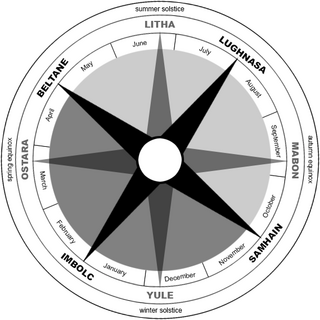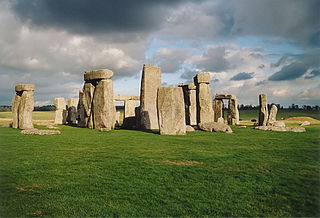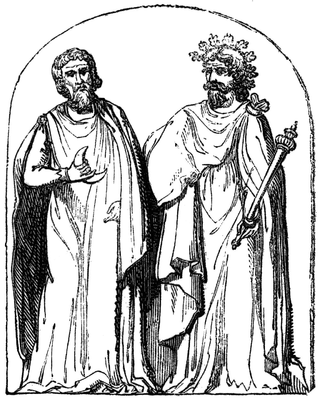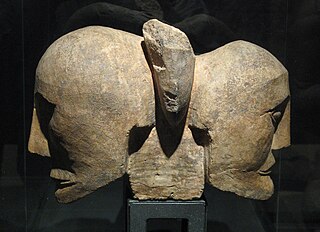Related Research Articles

The Celts or Celtic peoples were a collection of Indo-European peoples in Europe and Anatolia,identified by their use of Celtic languages and other cultural similarities. Major Celtic groups included the Gauls;the Celtiberians and Gallaeci of Iberia;the Britons,Picts,and Gaels of Britain and Ireland;the Boii;and the Galatians. The interrelationships of ethnicity,language and culture in the Celtic world are unclear and debated;for example over the ways in which the Iron Age people of Britain and Ireland should be called Celts. In current scholarship,'Celt' primarily refers to 'speakers of Celtic languages' rather than to a single ethnic group.
Samhain or Sauin is a Gaelic festival on 1 November marking the end of the harvest season and beginning of winter or the "darker half" of the year. It is also the Irish and Scottish Gaelic name for November. Celebrations begin on the evening of 31 October,since the Celtic day began and ended at sunset. This is about halfway between the autumnal equinox and winter solstice. It is one of the four Gaelic seasonal festivals along with Imbolc,Bealtaine,and Lughnasa. Historically it was widely observed throughout Ireland,Scotland,and the Isle of Man. Its Brittonic Celtic equivalent is called Calan Gaeaf in Wales.

The Wheel of the Year is an annual cycle of seasonal festivals,observed by a range of modern pagans,marking the year's chief solar events and the midpoints between them. Modern pagan observances are based to varying degrees on folk traditions,regardless of the historical practices of world civilizations. British neopagans popularized the Wheel of the Year in the mid-20th century,combining the four solar events marked by many European peoples,with the four midpoint festivals celebrated by Insular Celtic peoples.

Belatucadros or Belatucadrus,was a deity worshipped in Celtic northern Britain,particularly in Cumberland and Westmorland. In the Roman period he was identified with Mars and appears to have been worshipped by lower-ranked Roman soldiers as well as by Britons. In five inscriptions he is called Mars Belatucadrus and the name is frequently translated as "fair shining one" or "fair slayer."

A wicker man was purportedly a large wicker statue in which the druids sacrificed humans and animals by burning. The primary evidence for this practice is a sentence by Roman general Julius Caesar in his Commentary on the Gallic War,which modern scholarship has linked to an earlier Greek writer,Posidonius.

Saint Ciarán of Clonmacnoise,supposedly born Ciarán mac an tSaeir,was one of the Twelve Apostles of Ireland and the first abbot of Clonmacnoise. He is sometimes called Ciarán the Younger to distinguish him from the 5th-century Saint Ciarán the Elder who was bishop of Osraige. His name produced many variant spellings,including Ceran,Kieran,Queran and Queranus.

Ancient Celtic religion,commonly known as Celtic paganism,was the religion of the ancient Celtic peoples of Europe. Because there are no extant native records of their beliefs,evidence about their religion is gleaned from archaeology,Greco-Roman accounts,and literature from the early Christian period. Celtic paganism was one of a larger group of polytheistic Indo-European religions of Iron Age Europe.

Celtic neopaganism refers to any type of modern paganism or contemporary pagan movements based on the ancient Celtic religion. One approach is Celtic Reconstructionism (CR),which emphasizes historical accuracy in reviving Celtic traditions. CR practitioners rely on historical sources and archaeology for their rituals and beliefs,including offerings to spirits and deities. Language study and preservation are essential,and daily life often incorporates ritual elements. While distinct from eclectic pagan and neopagan witchcraft traditions,there is some overlap with Neo-druidism.
Ellen Evert Hopman is an author of both fiction and non-fiction,an herbalist,a lay homeopath,a lecturer,and a mental health counselor who lives and works in Western Massachusetts. She is the author of several books and audio tapes on Paganism and Druidry,and three novels.
Miranda Jane Aldhouse-Green,is a British archaeologist and academic,known for her research on the Iron Age and the Celts. She was Professor of Archaeology at Cardiff University from 2006 to 2013. Until about 2000,she published as Miranda Green or Miranda J. Green.

The Modern Pagan movement in the United Kingdom is primarily represented by Wicca and Neopagan witchcraft,Druidry,and Heathenry. 74,631 people in England,Scotland and Wales identified as either as Pagan or a member of a specific Modern Pagan group in the 2011 UK Census.
According to classical sources,the ancient Celts were animists. They honoured the forces of nature,saw the world as inhabited by many spirits,and saw the Divine manifesting in aspects of the natural world.

Celtic mythology is the body of myths belonging to the Celtic peoples. Like other Iron Age Europeans,Celtic peoples followed a polytheistic religion,having many gods and goddesses. The mythologies of continental Celtic peoples,such as the Gauls and Celtiberians,did not survive their conquest by the Roman Empire,the loss of their Celtic languages and their subsequent conversion to Christianity. Only remnants are found in Greco-Roman sources and archaeology. Most surviving Celtic mythology belongs to the Insular Celtic peoples. They preserved some of their myths in oral lore,which were eventually written down by Christian scribes in the Middle Ages. Irish mythology has the largest written body of myths,followed by Welsh mythology.

Druidry,sometimes termed Druidism,is a modern spiritual or religious movement that promotes the cultivation of honorable relationships with the physical landscapes,flora,fauna,and diverse peoples of the world,as well as with nature deities,and spirits of nature and place. Theological beliefs among modern Druids are diverse;however,all modern Druids venerate the divine essence of nature.

A druid was a member of the high-ranking priestly class in ancient Celtic cultures. Druids were religious leaders as well as legal authorities,adjudicators,lorekeepers,medical professionals and political advisors. Druids left no written accounts. While they were reported to have been literate,they are believed to have been prevented by doctrine from recording their knowledge in written form. Their beliefs and practices are attested in some detail by their contemporaries from other cultures,such as the Romans and the Greeks.

The Hexham Heads were a pair of small stone heads,about 6 cm high,found in 1971 in the English town of Hexham. The heads became associated with alleged paranormal phenomena,and their exact origin is a point of controversy.

The Christianisation of Scotland was the process by which Christianity spread in what is now Scotland,which took place principally between the fifth and tenth centuries.

The Corleck Head is an Irish three-faced stone idol usually dated to the 1st or 2nd century AD. Although its origin is not known for certain,its placing in the Early Iron Age is based on the iconography,which is similar to that of other northern European Celtic artefacts from that period. Archaeologists agree that it probably depicts a Celtic god and was intended to be placed on top of a larger shrine associated with a Celtic head cult. During the early Christian period,the hill became a major site for celebrating the Lughnasadh,a Gaelic pagan harvest festival that in Corleck continued into the modern period.

The Celts is a 2000 television documentary series produced by Opus Television for the Welsh channel S4C. A book adaptation of the same name by John Davies was published in the same year by Cassell &Co. Also in that year,the programme was sold to the American cable network Celtic Vision.

Celtic stone idols are Northern European stone sculptures dated to the Iron Age,that are believed to represent Celtic gods. The majority contain one or more human heads,which may have one or more faces. It is thought that the heads were often placed on top of pillar stones and were a centrepiece at cultic worship sites. They can be found across Northern Europe but are most numerous in Gaul and the British Isles,with the majority dating to the Romano-British and Gallo-Roman periods. Thus,they are sometimes described as a result of cultural exchange between abstract Celtic art and the Roman tradition of monumental stone carving. Parallels are found in contemporary Scandinavia.
References
- 1 2 Ross, Anne (2000-11-01). Folklore of the Scottish Highlands. The History Press. ISBN 978-0-7509-5245-3.
- ↑ "Anne Ross". Women in Cornwall. Retrieved 2024-11-14.
- ↑ "The 'half-man half-beast' who has roamed Hexham and haunted families for decades". Hexham Courant . 2024-10-19. Retrieved 2024-11-21.